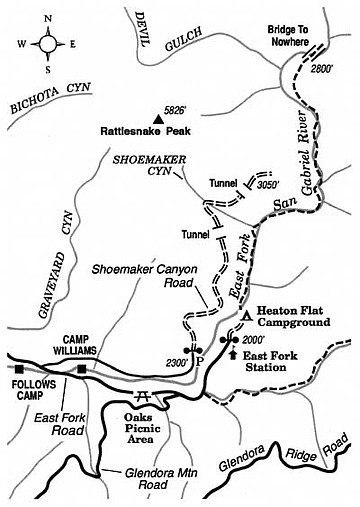 Facebook
Facebook
 X
X
 Instagram
Instagram
 TikTok
TikTok
 Youtube
Youtube
Known by some as the Convict Road, Shoemaker Canyon Road really should be called the "Road to Nowhere." The dead-end road was the first phase of a projected 23-year effort to build a 2-lane highway up the formidably steep East Fork San Gabriel River canyon to as far as Angeles Crest Highway. (In the bottom of the river canyon below Shoemaker Canyon Road, there stands a marooned structure, dating from an earlier and unrelated failed road project, dubbed the "Bridge to Nowhere.")
During 1954-69, the Los Angeles County road department, utilizing prison labor, managed to carve out and grade 4.5 miles of new roadway on almost impossibly steep slopes. What was the rationale for this road project? So that people from the L.A. basin could quickly escape the effects of a feared nuclear attack! Why was the project abandoned in 1969? Because of budget cuts, opposition by conservationists, and a muting of Cold War paranoia. The creation of the Sheep Mountain Wilderness area in 1984 finally put to rest, once and for all, a project that would have irreparably scarred Southern California's deepest canyon: the Narrows of the East Fork.
Today you can drive the first 1.8 miles of Shoemaker Canyon Road on pavement, then walk or mountain-bike the remaining graded-dirt section, going steadily uphill, to reach a pair of tunnels. Don't do this in the hot midday sun, as there is virtually no shade except for the tunnel passages.
From Highway 39 north of Azusa, drive east on East Fork Road 3.3 miles to where you bear left on the paved Shoemaker Canyon Road. Continue 1.8 miles to a sturdy gate and parking area. Travel ahead by motorized vehicles is prohibited. Parking here requires a National Forest Adventure Pass.
Head uphill on the dirt road that continues beyond the gate. After 1.7 miles of walking or biking, you reach the first tunnel, about 400 yards long, completed in 1961. Ahead lies a small abyss -- Shoemaker Canyon. It was never bridged; a narrower road contours around it and continues northeast to a second tunnel, about 250 yards long, dated 1964. On the far side of that tunnel, you can veer right and backtrack, circumventing the tunnel by way of an old road bed. There you'll have the best view of the "Narrows" part of the gorge, which lies beyond the Bridge to Nowhere. On the right (east) side of the Narrows, the canyon wall soars a vertical mile to the 8007-foot summit of Iron Mountain.
This article contains information about a publicly owned recreation or wilderness area. Trails and pathways are not necessarily marked. Conditions can change rapidly. Hikers should be properly equipped and have safety and navigational skills. The Reader and Jerry Schad assume no responsibility for any adverse experience.


Known by some as the Convict Road, Shoemaker Canyon Road really should be called the "Road to Nowhere." The dead-end road was the first phase of a projected 23-year effort to build a 2-lane highway up the formidably steep East Fork San Gabriel River canyon to as far as Angeles Crest Highway. (In the bottom of the river canyon below Shoemaker Canyon Road, there stands a marooned structure, dating from an earlier and unrelated failed road project, dubbed the "Bridge to Nowhere.")
During 1954-69, the Los Angeles County road department, utilizing prison labor, managed to carve out and grade 4.5 miles of new roadway on almost impossibly steep slopes. What was the rationale for this road project? So that people from the L.A. basin could quickly escape the effects of a feared nuclear attack! Why was the project abandoned in 1969? Because of budget cuts, opposition by conservationists, and a muting of Cold War paranoia. The creation of the Sheep Mountain Wilderness area in 1984 finally put to rest, once and for all, a project that would have irreparably scarred Southern California's deepest canyon: the Narrows of the East Fork.
Today you can drive the first 1.8 miles of Shoemaker Canyon Road on pavement, then walk or mountain-bike the remaining graded-dirt section, going steadily uphill, to reach a pair of tunnels. Don't do this in the hot midday sun, as there is virtually no shade except for the tunnel passages.
From Highway 39 north of Azusa, drive east on East Fork Road 3.3 miles to where you bear left on the paved Shoemaker Canyon Road. Continue 1.8 miles to a sturdy gate and parking area. Travel ahead by motorized vehicles is prohibited. Parking here requires a National Forest Adventure Pass.
Head uphill on the dirt road that continues beyond the gate. After 1.7 miles of walking or biking, you reach the first tunnel, about 400 yards long, completed in 1961. Ahead lies a small abyss -- Shoemaker Canyon. It was never bridged; a narrower road contours around it and continues northeast to a second tunnel, about 250 yards long, dated 1964. On the far side of that tunnel, you can veer right and backtrack, circumventing the tunnel by way of an old road bed. There you'll have the best view of the "Narrows" part of the gorge, which lies beyond the Bridge to Nowhere. On the right (east) side of the Narrows, the canyon wall soars a vertical mile to the 8007-foot summit of Iron Mountain.
This article contains information about a publicly owned recreation or wilderness area. Trails and pathways are not necessarily marked. Conditions can change rapidly. Hikers should be properly equipped and have safety and navigational skills. The Reader and Jerry Schad assume no responsibility for any adverse experience.
